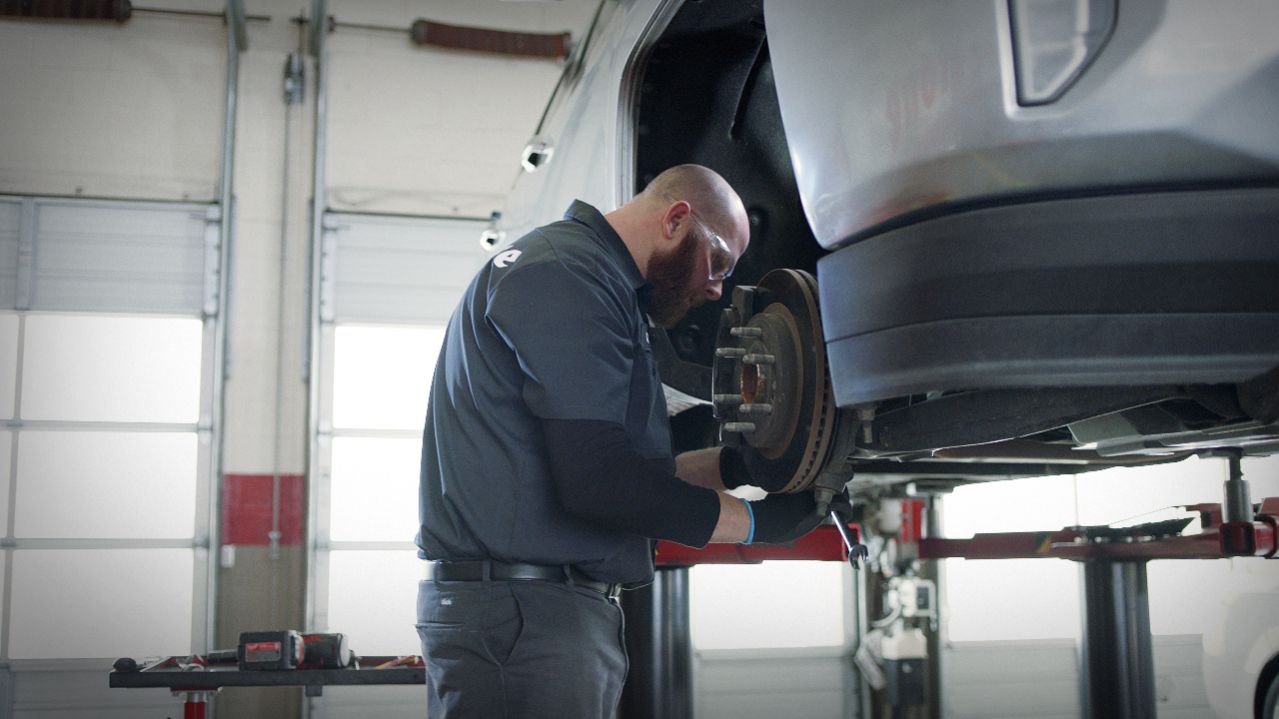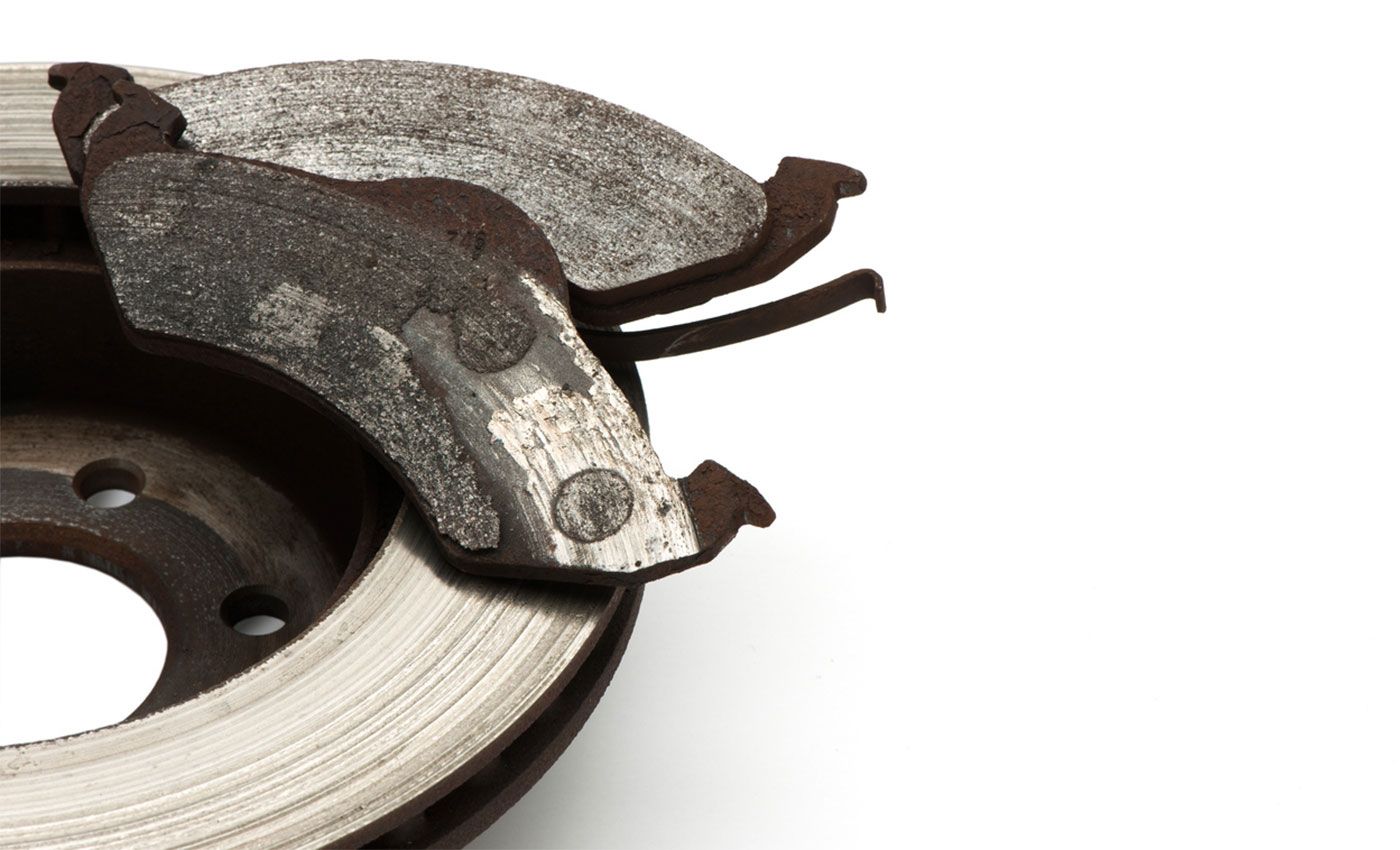You know that when you press down on your car’s brake pedal, the vehicle will slow down. Simple, right? But what parts of the braking system make stopping and slowing down possible?
Learning about the parts of a car brake system can help you better understand your vehicle, signs that components need to be replaced or repaired, and when it's time to seek out maintenance services. Keep reading to learn what the main parts of a braking system are and what to look for when they wear out.
Master Cylinder
The brake master cylinder is the first, and perhaps most important, component in your braking system because it sets the rest of the system in motion. The master cylinder is activated by pressing down on the brake pedal, which pushes a piston through the cylinder to force brake fluid through the brake lines.
In other words, the master cylinder creates hydraulic pressure that pushes the brake fluid down to the brake components on each wheel. The brake fluid reservoir sits on top of the master cylinder to supply it with fluid.
Symptoms of a Bad Master Cylinder
While master cylinders are designed to last the lifetime of your vehicle, they can sometimes suffer from leaks or other mechanical failures. Look out for these symptoms of a bad master cylinder:
- Abnormal brake pedal feel: A brake pedal that feels soft, squishy, or slowly sinks to the floor may indicate that the master cylinder has a leak or is otherwise not properly sealed.
- Dirty brake fluid: Brake fluid that appears dark brown or black may indicate that the master cylinder’s rubber seals have broken down and contaminated the fluid.
- Leaking fluid: A master cylinder whose seals have worn out may present visible leaks that drip brake fluid onto the ground beneath your vehicle.
- Check engine light: Your vehicle may be equipped with sensors that detect when the brake system loses pressure due to a faulty master cylinder, prompting a check engine light.
Brake Booster
Brake boosters are a component of power brake systems. They multiply the force applied by the brake pedal onto the master cylinder. Power brakes are found on many vehicles nowadays to make braking more manageable.
Without a brake booster, you would have to put in a lot more effort to slow down your car. Most brake boosters are vacuum-boosted, meaning the engine produces a vacuum inside the booster’s diaphragm to multiply force from the pedal.
Symptoms of a Bad Brake Booster
A failing brake booster can create dangerous driving conditions by making braking more difficult. Oftentimes, a brake booster fails due to a ruptured diaphragm or cracked vacuum hose. Here’s what to look for if you suspect your brake booster may be going bad:
- Stiff brake pedal: A brake pedal that is hard or extremely difficult to press down—and does not rise after being pressed—is one of the primary indicators of a bad brake booster.
- Longer stopping distance: a vehicle with a bad brake booster may be more difficult to stop and could result in longer stopping distances.
- Engine stalls when braking: If the diaphragm in your brake booster is ruptured, it may draw excess vacuum from the engine, causing it to stall.
Brake Fluid
Pressurized brake fluid is the medium by which the mechanical parts of your brake system are activated. It is sent from the brake fluid reservoir to the master cylinder. Then, through the brake lines, and down to the calipers or wheel cylinders (if the vehicle has rear drum brakes) at each wheel, which house the brake pads. This hydraulic fluid not only actuates the brake pads and rear shoes (if drum brake equipped) at each wheel, but it also acts as a lubricant and has anti-corrosion additives to keep your brake system healthy.
Symptoms of Bad Brake Fluid
Exchanging your brake fluid is a routine maintenance item that should be investigated approximately every two years or 30,000 miles. If your brake fluid is contaminated, sludgy, or its level is too low, you may encounter these symptoms:
- Soft brake pedal: A pedal that is overly soft and unresponsive may indicate a leak has caused you to lose too much brake fluid.
- Less effective brakes: Brake fluid that is contaminated with air or sludge won’t respond as effectively when pressurized, which may lead to longer stopping distances.
- Brake warning light: Your car may be equipped with a sensor in the brake fluid reservoir that activates the brake warning light on your dashboard if fluid levels drop too low.
Brake Lines & Hoses
Brake lines and hoses carry brake fluid from the master cylinder to the calipers on all four wheels. Brake lines are rigid metal tubes attached to the car's body, and they transport the fluid most of the way to the wheels. Brake hoses are found at the end of the brake lines and are used to bring the fluid the rest of the way to each caliper or wheel cylinder. Brake hoses are made of rubber to allow movement between the wheel and suspension.
Symptoms of Bad Brakes Lines & Hoses
Brake lines and hoses are made to last for tens of thousands of miles, but they should be inspected regularly to check for leaks or damage. Here’s how to check if your brake lines or hoses are going bad:
- Mushy brake pedal: If a line or hose has sprung a leak, it may compromise the pressure of the hydraulic fluid your brakes need to operate, leading to a dangerously soft pedal.
- Visibly worn brake hose: Exposure to weather and heat from the brakes over time may result in brake hoses that have cracks, tears, or frayed threads that can quickly turn into a leak.
Brake Caliper
Brake calipers are a component placed at each wheel and found only in disc brake systems. They act as a metal clamp on the wheel’s disc or rotor. When the brake pedal is applied, brake fluid activates a set of pistons inside the caliper, which presses brake pads against the rotor and slows the vehicle.
Symptoms of a Bad Brake Caliper
Brake calipers are built to last tens of thousands of miles without issue, but as they age, the piston(s) inside the caliper may get stuck or the caliper itself may leak or become stuck as well. Look for these symptoms of a bad brake caliper:
- Visible leaks: Constant exposure to the heat from braking can cause the caliper’s rubber seals to break down over time, which may result in brake fluid leaks under your vehicle and near the wheels.
- Less effective brakes: If the caliper has built up too much dirt and grime, the caliper sliders may become stuck, preventing the caliper from fully clamping down on the rotor and giving the brake pedal a spongy feel.
- Car pulls to one side: As a caliper begins to wear out from heat exposure, its pistons may seize and create drag on that particular wheel, causing it to pull to that side.
- Brakes engaged without pedal: A caliper that becomes stuck from dirt and grime may be unable to fully retract the brake pads from the rotor, making your ride feel like the brakes are partially engaged even when your foot is off the pedal.
Brake Pads & Shoes
Brake pads are found only in disc brake systems, while brake shoes are found in drum brake systems. With disc brakes, brake pads act as the friction material that is squeezed against a wheel’s rotor to slow it down. On drum brakes, brake shoes perform the same function, except they create friction by being pressed against the inside of a drum.
Symptoms of Bad Brake Pads
Brake pads are a routine maintenance item and need to be replaced at regular intervals. Depending on the type of pads you have, they may last anywhere between 20,000 to 70,000 miles. However, a better way to tell if your pads need replacing is by how thin they are. Brake pads should be replaced when they wear down to about 3 to 4 mm in thickness. Here are some symptoms of worn-out brake pads:
- Squealing noise: Some brake pads come with a built-in indicator that makes an audible squealing noise when they become too thin, letting you know they need to be replaced. If you hear a harsh grinding noise, this likely means the pads have completely worn out and are now pressing against their rotor with only their metal backplate. If you hear grinding, schedule an appointment as soon as possible to have your brake pads replaced.
- Less effective brakes: As brake pads wear out, their braking response worsens—especially during hard braking situations.
Brake Rotor & Drum
A brake rotor is a metal disc attached to the wheel hub, found only on disc brake systems. It rotates with the wheel so that when the brake pads squeeze the rotor, the whole wheel comes to a stop. In drum brake systems, the brake drum also rotates with the wheel, but it contains wheel cylinders and brake shoes that slow the rotation of the drum.
Symptoms of a Bad Brake Rotor
Brake rotors last longer than brake pads but suffer from similar wear due to heat and friction and will need to be replaced eventually—usually after tens of thousands of miles. Rotors can sometimes be resurfaced or replaced altogether. Watch out for these symptoms of a bad brake rotor:
- Squealing or scraping noises: A rotor that has become warped may make a squealing sound when applying the brakes and a scraping noise if the rotor is severely worn.
- Brake pedal vibrations: If one or more rotors are warped, it can cause irregular vibrations felt through the brake pedal or steering wheel (during braking).
- Grooves on the rotor: As brake pads and rotors wear out from contact, the rotor may be left with grooves or visible marks that may need to be resurfaced to maintain safe braking.
- Longer stopping distances: Rotors that are grooved, scored, or warped are overall less effective and can unsafely increase your stopping distance.
What Are the Different Types of Brakes?
Most modern vehicles come with two to three different types of brakes installed. These include disc brakes, drum brakes, and the parking brake. Disc brakes and drum brakes perform the same task of slowing your vehicle when the brake pedal is pressed but use different parts to do so.
Most cars have disc brakes on all four wheels, though some may have drum brakes on the back wheels as they are cheaper to manufacture. Here’s a quick breakdown of each type of brake:
- Disc Brakes: Standard hydraulic brake system that uses pistons housed in a caliper at each wheel to squeeze brake pads against a spinning disc rotor.
- Drum Brakes: Less common hydraulic brake system that uses wheel cylinders to push brake shoes against a spinning drum inside each wheel.
- Anti-Lock Brake System (ABS): An automatic emergency braking system that uses sensors to rapidly pump the hydraulic brakes to prevent them from locking up in sudden braking situations.
- Parking Brake: A mechanical braking system (sometimes electronic) that typically uses a hand-operated lever to lock the wheels in place on inclines, also known as the emergency brake.
Schedule Your Next Brake Service at Firestone Complete Auto Care
Understanding the components within your braking system can get tricky, but the experts at Firestone Complete Auto Care know everything there is to know about keeping them working the way they should. Along with a free brake inspection, we also offer all of the brake services, inspections, and repairs your vehicle needs. Stop by your nearest service center today!



